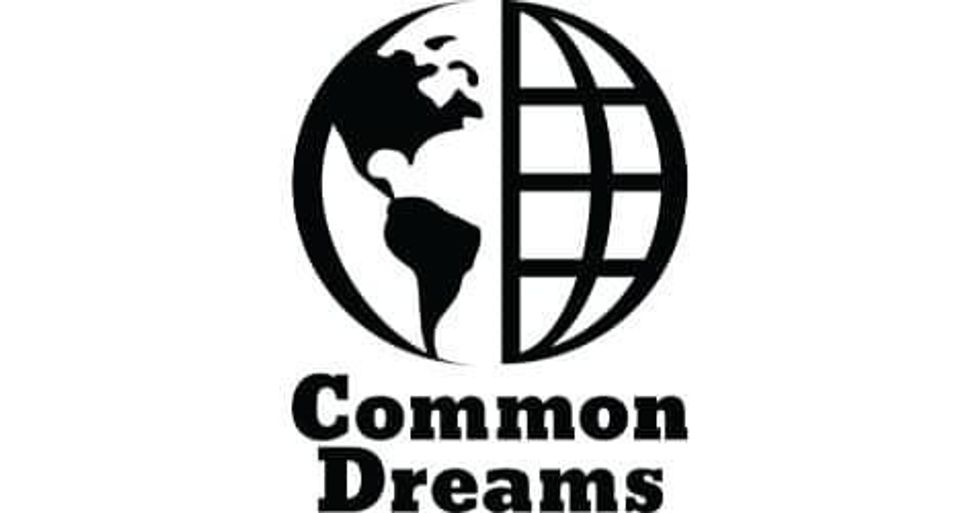

SUBSCRIBE TO OUR FREE NEWSLETTER
Daily news & progressive opinion—funded by the people, not the corporations—delivered straight to your inbox.
5
#000000
#FFFFFF
To donate by check, phone, or other method, see our More Ways to Give page.


Daily news & progressive opinion—funded by the people, not the corporations—delivered straight to your inbox.

As the U.S. turns to renewable energy, the question remains: who will benefit? (Photo: Conservation Law Foundation)
Among those concerned with the United States' energy future--including, increasingly, the utility companies themselves--the business model known as "Utility 2.0" appears as a beacon of hope. Utility 2.0 addresses the concerns of both energy watchdogs and conventional electricity utilities by offering the latter financial incentives to adopt greener, more flexible infrastructure. But while this new paradigm presents solutions to many of the problems associated with centralized, fossil fuel-reliant power grids, some argue that it does not go far enough.
Among those concerned with the United States' energy future--including, increasingly, the utility companies themselves--the business model known as "Utility 2.0" appears as a beacon of hope. Utility 2.0 addresses the concerns of both energy watchdogs and conventional electricity utilities by offering the latter financial incentives to adopt greener, more flexible infrastructure. But while this new paradigm presents solutions to many of the problems associated with centralized, fossil fuel-reliant power grids, some argue that it does not go far enough. In a December 2014 report from the Institute for Local Self-Reliance, John Farrell makes the case for a more radical shift, which he calls "Utility 3.0" or "energy democracy." By relocating control and ownership from the utilities to their customers, Farrell argues, Utility 3.0 allows communities to take advantage of the economic as well as the environmental benefits of the shift to clean energy.

Per Farrell's distillation, Utility 2.0 was formulated in response to a couple of trends. First is the flattening-out of both per capita electricity consumption and total electricity sales. Then there is the rise of renewables: renewable sources (excluding hydroelectricity) supplied 7 percent of the United States' electricity during the first part of 2014. Both developments threaten electric utilities' bottom line as long as the companies remain tied to a model oriented around fossil fuels and one-way distribution from centralized power plants.
To enable the reduction of carbon emissions and the transition to a more efficient, flexible electricity grid without bankrupting existing utilities, Utility 2.0 proposes a collection of changes to the conventional model. Though details of the various proposals under the Utility 2.0 umbrella vary, they tend to return to two key policies. One is decoupling, or separating a utility's economic well-being from the quantity of electricity sold. The other core policy is the separation of utility profits from the construction and ownership of infrastructure. A number of states have enacted Utility 2.0-friendly changes to their regulatory environment. Farrell points to Vermont as a particularly complete case, noting that the expected closure of a nuclear power plant there hastened developments already underway since the late 1990s.

The Vermont example is especially intriguing for Farrell because it includes two policies oriented toward non-utility actors: net metering (in which household energy production is factored into customers' utility bills) and a feed-in tariff (in which small-scale producers are paid for the energy they supply to the grid). These and other measures, argues Farrell, can support the broader redistribution of energy planning and control, away from monopolistic, for-profit utility companies and toward electricity consumers.

Farrell lays out the requirement for true "energy democracy," which include not just the technological developments associated with Utility 2.0 (such as smartphone apps and smart appliances) but financial mechanisms like on-bill repayment and community organizing and education, particularly in underserved areas. "Managing energy should be as easy as managing a mutual fund by selecting a 'moderate' or 'aggressive' portfolio," Farrell writes. "And these tools have to be ubiquitous and affordable . . . to ensure access."
Farrell acknowledges that the achievement of Utility 3.0 remains a hoped-for rather than probable future scenario. After all, the Utility 2.0-oriented work several states have already undertaken has largely involved patchwork, rather than a fundamental restructuring of the energy economy. That said, the stakes are high, in economic as well as environmental terms, as the path forward--Utility 2.0, 3.0, or an alternative model--will determine the ultimate beneficiaries of the $364 billion market for electricity.
Trump and Musk are on an unconstitutional rampage, aiming for virtually every corner of the federal government. These two right-wing billionaires are targeting nurses, scientists, teachers, daycare providers, judges, veterans, air traffic controllers, and nuclear safety inspectors. No one is safe. The food stamps program, Social Security, Medicare, and Medicaid are next. It’s an unprecedented disaster and a five-alarm fire, but there will be a reckoning. The people did not vote for this. The American people do not want this dystopian hellscape that hides behind claims of “efficiency.” Still, in reality, it is all a giveaway to corporate interests and the libertarian dreams of far-right oligarchs like Musk. Common Dreams is playing a vital role by reporting day and night on this orgy of corruption and greed, as well as what everyday people can do to organize and fight back. As a people-powered nonprofit news outlet, we cover issues the corporate media never will, but we can only continue with our readers’ support. |
Among those concerned with the United States' energy future--including, increasingly, the utility companies themselves--the business model known as "Utility 2.0" appears as a beacon of hope. Utility 2.0 addresses the concerns of both energy watchdogs and conventional electricity utilities by offering the latter financial incentives to adopt greener, more flexible infrastructure. But while this new paradigm presents solutions to many of the problems associated with centralized, fossil fuel-reliant power grids, some argue that it does not go far enough. In a December 2014 report from the Institute for Local Self-Reliance, John Farrell makes the case for a more radical shift, which he calls "Utility 3.0" or "energy democracy." By relocating control and ownership from the utilities to their customers, Farrell argues, Utility 3.0 allows communities to take advantage of the economic as well as the environmental benefits of the shift to clean energy.

Per Farrell's distillation, Utility 2.0 was formulated in response to a couple of trends. First is the flattening-out of both per capita electricity consumption and total electricity sales. Then there is the rise of renewables: renewable sources (excluding hydroelectricity) supplied 7 percent of the United States' electricity during the first part of 2014. Both developments threaten electric utilities' bottom line as long as the companies remain tied to a model oriented around fossil fuels and one-way distribution from centralized power plants.
To enable the reduction of carbon emissions and the transition to a more efficient, flexible electricity grid without bankrupting existing utilities, Utility 2.0 proposes a collection of changes to the conventional model. Though details of the various proposals under the Utility 2.0 umbrella vary, they tend to return to two key policies. One is decoupling, or separating a utility's economic well-being from the quantity of electricity sold. The other core policy is the separation of utility profits from the construction and ownership of infrastructure. A number of states have enacted Utility 2.0-friendly changes to their regulatory environment. Farrell points to Vermont as a particularly complete case, noting that the expected closure of a nuclear power plant there hastened developments already underway since the late 1990s.

The Vermont example is especially intriguing for Farrell because it includes two policies oriented toward non-utility actors: net metering (in which household energy production is factored into customers' utility bills) and a feed-in tariff (in which small-scale producers are paid for the energy they supply to the grid). These and other measures, argues Farrell, can support the broader redistribution of energy planning and control, away from monopolistic, for-profit utility companies and toward electricity consumers.

Farrell lays out the requirement for true "energy democracy," which include not just the technological developments associated with Utility 2.0 (such as smartphone apps and smart appliances) but financial mechanisms like on-bill repayment and community organizing and education, particularly in underserved areas. "Managing energy should be as easy as managing a mutual fund by selecting a 'moderate' or 'aggressive' portfolio," Farrell writes. "And these tools have to be ubiquitous and affordable . . . to ensure access."
Farrell acknowledges that the achievement of Utility 3.0 remains a hoped-for rather than probable future scenario. After all, the Utility 2.0-oriented work several states have already undertaken has largely involved patchwork, rather than a fundamental restructuring of the energy economy. That said, the stakes are high, in economic as well as environmental terms, as the path forward--Utility 2.0, 3.0, or an alternative model--will determine the ultimate beneficiaries of the $364 billion market for electricity.
Among those concerned with the United States' energy future--including, increasingly, the utility companies themselves--the business model known as "Utility 2.0" appears as a beacon of hope. Utility 2.0 addresses the concerns of both energy watchdogs and conventional electricity utilities by offering the latter financial incentives to adopt greener, more flexible infrastructure. But while this new paradigm presents solutions to many of the problems associated with centralized, fossil fuel-reliant power grids, some argue that it does not go far enough. In a December 2014 report from the Institute for Local Self-Reliance, John Farrell makes the case for a more radical shift, which he calls "Utility 3.0" or "energy democracy." By relocating control and ownership from the utilities to their customers, Farrell argues, Utility 3.0 allows communities to take advantage of the economic as well as the environmental benefits of the shift to clean energy.

Per Farrell's distillation, Utility 2.0 was formulated in response to a couple of trends. First is the flattening-out of both per capita electricity consumption and total electricity sales. Then there is the rise of renewables: renewable sources (excluding hydroelectricity) supplied 7 percent of the United States' electricity during the first part of 2014. Both developments threaten electric utilities' bottom line as long as the companies remain tied to a model oriented around fossil fuels and one-way distribution from centralized power plants.
To enable the reduction of carbon emissions and the transition to a more efficient, flexible electricity grid without bankrupting existing utilities, Utility 2.0 proposes a collection of changes to the conventional model. Though details of the various proposals under the Utility 2.0 umbrella vary, they tend to return to two key policies. One is decoupling, or separating a utility's economic well-being from the quantity of electricity sold. The other core policy is the separation of utility profits from the construction and ownership of infrastructure. A number of states have enacted Utility 2.0-friendly changes to their regulatory environment. Farrell points to Vermont as a particularly complete case, noting that the expected closure of a nuclear power plant there hastened developments already underway since the late 1990s.

The Vermont example is especially intriguing for Farrell because it includes two policies oriented toward non-utility actors: net metering (in which household energy production is factored into customers' utility bills) and a feed-in tariff (in which small-scale producers are paid for the energy they supply to the grid). These and other measures, argues Farrell, can support the broader redistribution of energy planning and control, away from monopolistic, for-profit utility companies and toward electricity consumers.

Farrell lays out the requirement for true "energy democracy," which include not just the technological developments associated with Utility 2.0 (such as smartphone apps and smart appliances) but financial mechanisms like on-bill repayment and community organizing and education, particularly in underserved areas. "Managing energy should be as easy as managing a mutual fund by selecting a 'moderate' or 'aggressive' portfolio," Farrell writes. "And these tools have to be ubiquitous and affordable . . . to ensure access."
Farrell acknowledges that the achievement of Utility 3.0 remains a hoped-for rather than probable future scenario. After all, the Utility 2.0-oriented work several states have already undertaken has largely involved patchwork, rather than a fundamental restructuring of the energy economy. That said, the stakes are high, in economic as well as environmental terms, as the path forward--Utility 2.0, 3.0, or an alternative model--will determine the ultimate beneficiaries of the $364 billion market for electricity.